Soil Recycling of Waste Biomass in the Production of Malus domestica Fruit Tree Seedlings
Abstract
1. Introduction
2. Materials and Methods
2.1. Field Experiment Designed
- ▪
- 0—control;
- ▪
- I—2 t ha−1;
- ▪
- II—3 t ha−1;
- ▪
- III—5 t ha−1.
2.2. Meteorological Conditions during Study Period
- ▪
- P—the sum of atmospheric precipitation for a given decade [mm],
- ▪
- Σt—the sum of average daily air temperatures for a given decade [°C].
- ▪
- extremely dry—k ≤ 0.4
- ▪
- very dry—0.4 < k ≤ 0.7
- ▪
- dry—0.7 < k ≤ 1.0
- ▪
- fairly dry—1.0 < k ≤ 1.3
- ▪
- optimal—1.3 < k ≤ 1.6
- ▪
- fairly humid—1.6 < k ≤ 2.0
- ▪
- humid—2.0 < k ≤ 2.5
- ▪
- very humid—2.5 < k ≤ 3.0
- ▪
- extremely humid—k > 3.0
2.3. Characteristics of Waste Biomass Used in the Experiment
2.4. Soil Analysis
- ▪
- pH in 1 mol dm−3 KCl—determined by the potentiometric method using a Hanna Instruments 4221 pH meter (Nusfalau; Romania), maintaining a soil-to-solution ratio of 1:2.5;
- ▪
- Electrical conductivity (EC) of aqueous soil extracts—determined by the potentiometric method using a Hanna Instruments HI 2316 conductivity meter (Hanna Instruments; Nusfalau, Romania), maintaining a soil-to-solution ratio of 1:5;
- ▪
- Organic carbon content (SOC)—determined by the oxidation-titration method [20]; In the conducted studies, soil organic carbon (SOC) was defined as the pool of organic carbon present in the soil, which also included carbon originating from undecomposed fragments of wood chips introduced into the soil. Even if the organic matter was coarse, if it passed through a 2 mm mesh, it was classified as soil organic matter. This represents a potential pool of organic matter that, through further processes, will be transformed into soil humus.
- ▪
- Total nitrogen content—determined by the Kjeldahl method [20];
- ▪
- Content of available forms of macroelements and microelements (P, K, Mg, Fe, Mn, Zn, Cu)—phosphorus in extracts was determined colorimetrically using a Schimadzu 2600 UV-VIS spectrophotometer (Tokyo, Japan), while the remaining elements were determined by atomic absorption spectrometry (AAS) using a HITACHI Z-2000 apparatus (HITACHI; Tokyo, Japan) [20].
2.5. Statistical Analysis
3. Results and Discussion
3.1. The Metrological Data
3.2. Soil pH and the Content of Available Forms of Macronutrients
3.3. Content of Soluble Forms of Micronutrients
3.4. The Effect of Fertilisation with Waste Biomass Chips on the Quantity and Quality of Nursery Stock Obtained
4. Conclusions
Author Contributions
Funding
Institutional Review Board Statement
Data Availability Statement
Conflicts of Interest
References
- Ekschmitta, K.; Liub, M.; Vettera, S.; Fox, O.; Wolters, V. Strategies used by soil biota to overcome soil organic matter stability-why is dead organic matter left over in the soil? Geoderma 2005, 128, 167–176. [Google Scholar] [CrossRef]
- Loveland, P.; Webb, J. Is there a critical level of organic matter in the agricultural soils of temperate regions: A review. Soil. Tillage Res. 2003, 70, 1–18. [Google Scholar] [CrossRef]
- Gonet, S. Problems of protecting soil organic matter resources-conditions and recommendations. In Methods of Testing Humus Substances in Aquatic and Land Ecosystems; Publishing House AR: Szczecin, Poland, 2004; pp. 7–14. (In Polish) [Google Scholar]
- Yang, C.; Yanga, L.; Ouyang, Z. Organic carbon and its fractions in paddy soil as affected by different nutrient and water regimes. Geoderma 2005, 124, 133–142. [Google Scholar] [CrossRef]
- Gorzelany, J.; Matłok, N. Energy analysis of waste biomass from production of fruit trees on the territory of Podkarpackie voivoideship. Agric. Eng. 2013, 146, 77–83. (In Polish) [Google Scholar]
- Roman, M.; Roman, K. Energy use of wood waste from fruit trees on the example of an agritourism farm. Rocz. Nauk. SERI 2018, XX, 158–161. (In Polish) [Google Scholar] [CrossRef]
- Nati, C.; Boschiero, M.; Picchi, G.; Mastrolonardo, G.; Kelderer, M.; Zerbe, S. Energy performance of a new biomass harvester for recovery of orchard wood wastes as alternative to mulching. Renew. Energy 2018, 124, 121–128. [Google Scholar] [CrossRef]
- ORC Organic Research Centre. Ramial Woodchip in Agricultural Production WOOFS Technical Guide 2. 2020. Available online: https://www.organicresearchcentre.com/wp-content/uploads/2020/12/WOOFS_TG2_Final.pdf (accessed on 10 October 2024).
- Fontana, M.; Johanes, A.; Zaccone, C.; Weisskopf, P.; Guillaume, T.; Bragazza, L.; Elfouki, S.; Charles, R.; Sinaj, S. Improving crop nutrition, soil carbon storage and soil physical fertility using ramial wood chips. Environ. Technol. Innov. 2023, 31, 103143. [Google Scholar] [CrossRef]
- Zhigang, L.; Schneider, R.L.; Morreale, S.J.; Xie, Y.; Li, C.; Li, J. Woody organic amendments for retaining soil water, improving soil properties and enhancing plant growth in desertified soils of Ningxia, China. Geoderma 2018, 310, 143–152. [Google Scholar]
- Donk, S.J.; Lindgren, D.T.; Schaaf, D.M.; Petersen, J.L.; Tarkalson, D.D. Wood chip mulch thickness effects on soil water, soil temperature, weed growth and landscape plant growth. J. Appl. Hortic. 2011, 13, 91–95. [Google Scholar] [CrossRef]
- Treder, W.; Klamkowski, K.; Krzewińska, D.; Tryngiel-Gać, A. The latest trends in irrigation technology research related to irrigation of fruit crops conducted at the research institute of pomology and floriculturae in Skierniewice. Infrastruct. Ecol. Rural Areas 2009, 6, 95–107. (In Polish) [Google Scholar]
- Scharenbroch, B.C.; Watson, G.W. Wood Chips and Compost Improve Soil Quality and Increase Growth of Acer rubrum and Betula nigra in Compacted Urban Soil. Arboric. Urban For. 2014, 40, 319–331. [Google Scholar] [CrossRef]
- Gholami, L.; Darvishan, A.K.; Kavian, A. Wood chips as soil conservation in field conditions. Arab. J. Geosci. 2016, 9, 1–11. [Google Scholar] [CrossRef]
- Tahboub, M.B.; Lindemann, W.C.; Murray, L. Chemical and Physical Properties of Soil Amended with Pecan Wood Chips. HortSci. Horts 2008, 43, 891–896. [Google Scholar] [CrossRef]
- WRB. World Reference Base for Soil Resources 2014. In Update, World Soil Resources Reports, 106; FAO: Rome, Italy, 2015. [Google Scholar]
- Fertilization Recommendations. Part I. Limit Numbers for the Evaluation of the Content Macro-Soils and Micronutrients in Soils; Series, P., Ed.; IUNG-PIB: Puławy, Poland, 1990; Volume 44, pp. 1–26. (In Polish) [Google Scholar]
- Radzka, E.; Rymuza, K.; Lenartowicz, T. Analysis of hydrothermal conditions and their impact on early potato yields. J. Ecol. Eng. 2015, 16, 120–124. [Google Scholar] [CrossRef]
- Skowera, B.; Puła, J. Extreme pluviothermic conditions in spring in Poland in the years 1971–2000. Acta Agrophys. 2004, 3, 171–177. (In Polish) [Google Scholar]
- Page, A.L.; Miller, R.H.; Keeney, D.R. Methods of Soil Analysis, Part 2: Chemical and Microbiological Properties, 2nd ed.; Agron No 9; American Society of Agronomy: Madison, WI, USA, 1982. [Google Scholar]
- Matłok, N.; Gorzelany, J. Assessment of cost and energy effectiveness of modified technologies for production of young fruit trees, taking into account the use of waste biomass for energy and soil amendment related purposes. Energy 2020, 190, 116428. [Google Scholar] [CrossRef]
- Cukor, J.; Vacek, Z.; Vacek, S.; Linda, R.; Podrázský, V. Biomass productivity, forest stability, carbon balance, and soil transformation of agricultural land afforestation: A case study of suitability of native tree species in the submontane zone in Czechia. CATENA 2022, 210, 105893. [Google Scholar] [CrossRef]
- Finch, H.J.S.; Samuel, A.M.; Lane, G.P.F. Fertilisers and Manures. In Lockhart & Wiseman’s Crop Husbandry Including Grassland; Woodhead Publishing: Cambridge, UK, 2014. [Google Scholar] [CrossRef]
- Chandrasekaran, S.R.; Hopke, P.K.; Rector, L.; Allen, G.; Lin, L. Chemical Composition of Wood Chips and Wood Pellets. Energy Fuels 2012, 26, 4932–4937. [Google Scholar] [CrossRef]
- Lal, R. Challenges and opportunities in soil organic matter research. Eur. J. Soil Sci. 2009, 60, 158–169. [Google Scholar] [CrossRef]
- Rajor, A.; Sharma, R.; Sood, V.K.; Ramamurthy, V. A sawdust-derived soil conditioner promotes plant growth and improves water-holding capacity of different types of soils. J. Ind. Microbiol. Biotechnol. 1996, 16, 237–240. [Google Scholar] [CrossRef]
- Sari, Y.W.; Bruins, M.E.; Sanders, J.P.M. Enzyme assisted protein extraction from rapeseed, soybean, and microalgae meals. Ind. Crops Prod. 2013, 43, 78–83. [Google Scholar] [CrossRef]
- Bilandzija, N.; Voca, N.; Kricka, T.; Matin, A.; Jurisic, V. Energy potential of fruit tree pruned biomass in Croatia. Span. J. Agric. Res. 2012, 10, 292–298. [Google Scholar] [CrossRef]
- Speir, T.W.; Van Schaik, A.P.; Percival, H.J.; Close, M.E.; Pang, L. Heavy Metals in Soil, Plants and Groundwater Following High-Rate Sewage Sludge Application to Land. Water Air Soil Pollut. 2003, 150, 319–358. [Google Scholar] [CrossRef]
- Smyrnov, V.; Mitryasova, O.; Salamon, I.; Smyrnova, S.; Chvyr, V.; Mats, A. The Distribution of Heavy Metal Forms in the Industrial-Urban Agglomeration Soil. J. Ecol. Eng. 2023, 24, 303–313. [Google Scholar] [CrossRef]
- Pfleiderer, P.; Menke, I.; Schleussner, C.F. Increasing risks of apple tree frost damage under climate change. Clim. Chang. 2019, 157, 515–525. [Google Scholar] [CrossRef]
- Mészáros, M.; Hnátková, H.; Čonka, P.; Lošák, T.; Náměstek, J. Effect of spring nitrogen fertilization on bearing and branching behaviors of young apple trees. PLoS ONE 2023, 18, e0285194. [Google Scholar] [CrossRef]
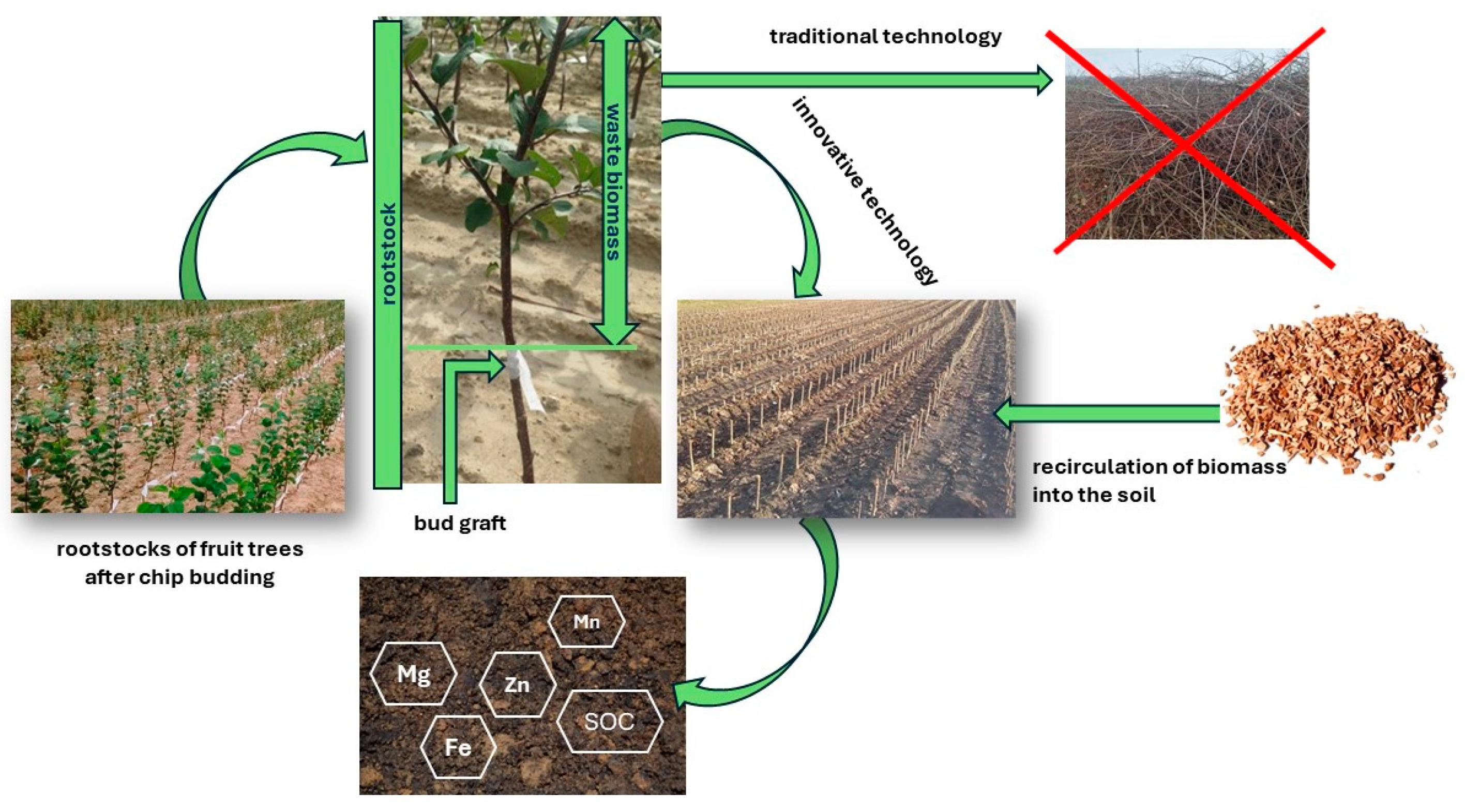

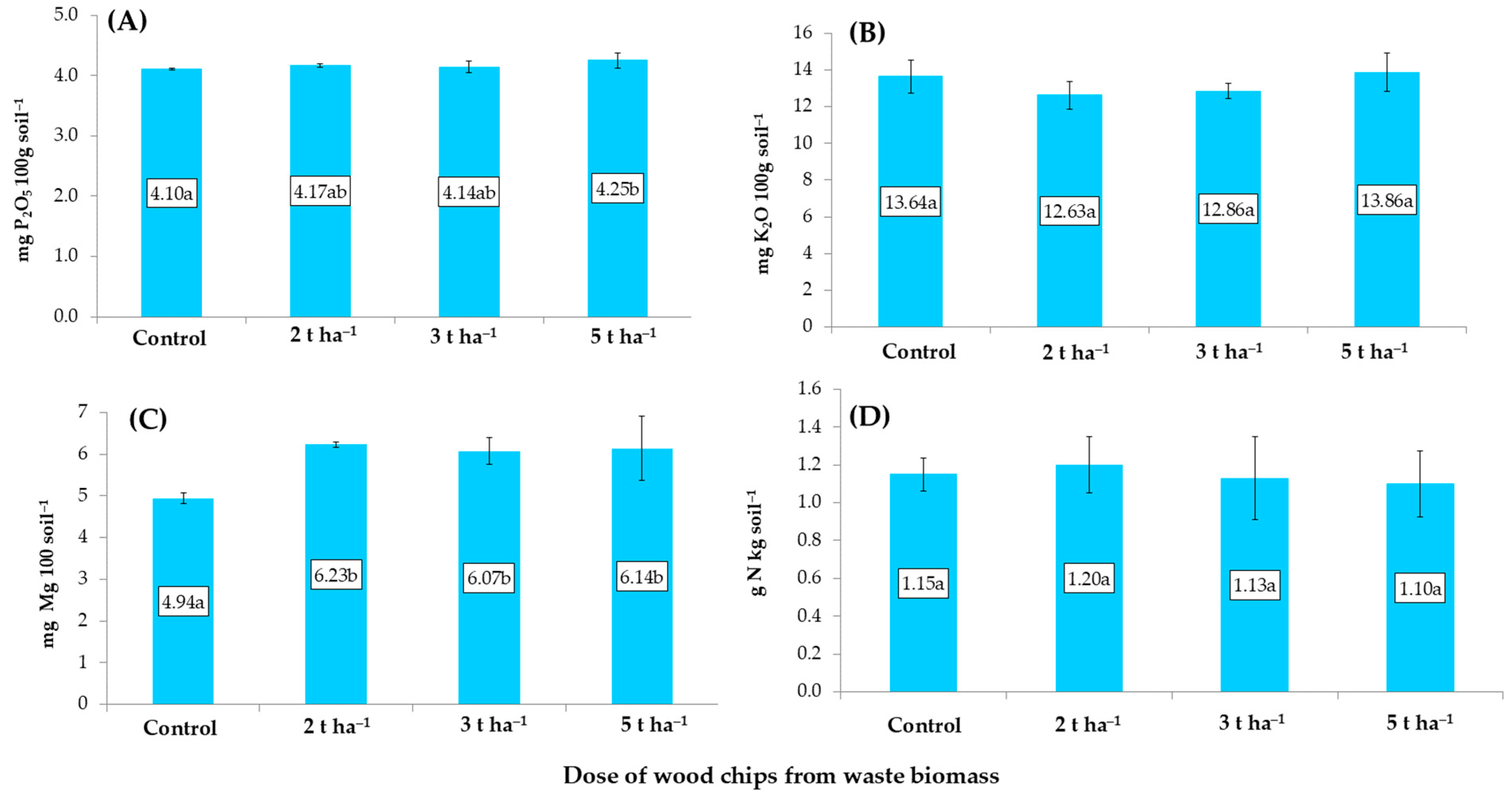
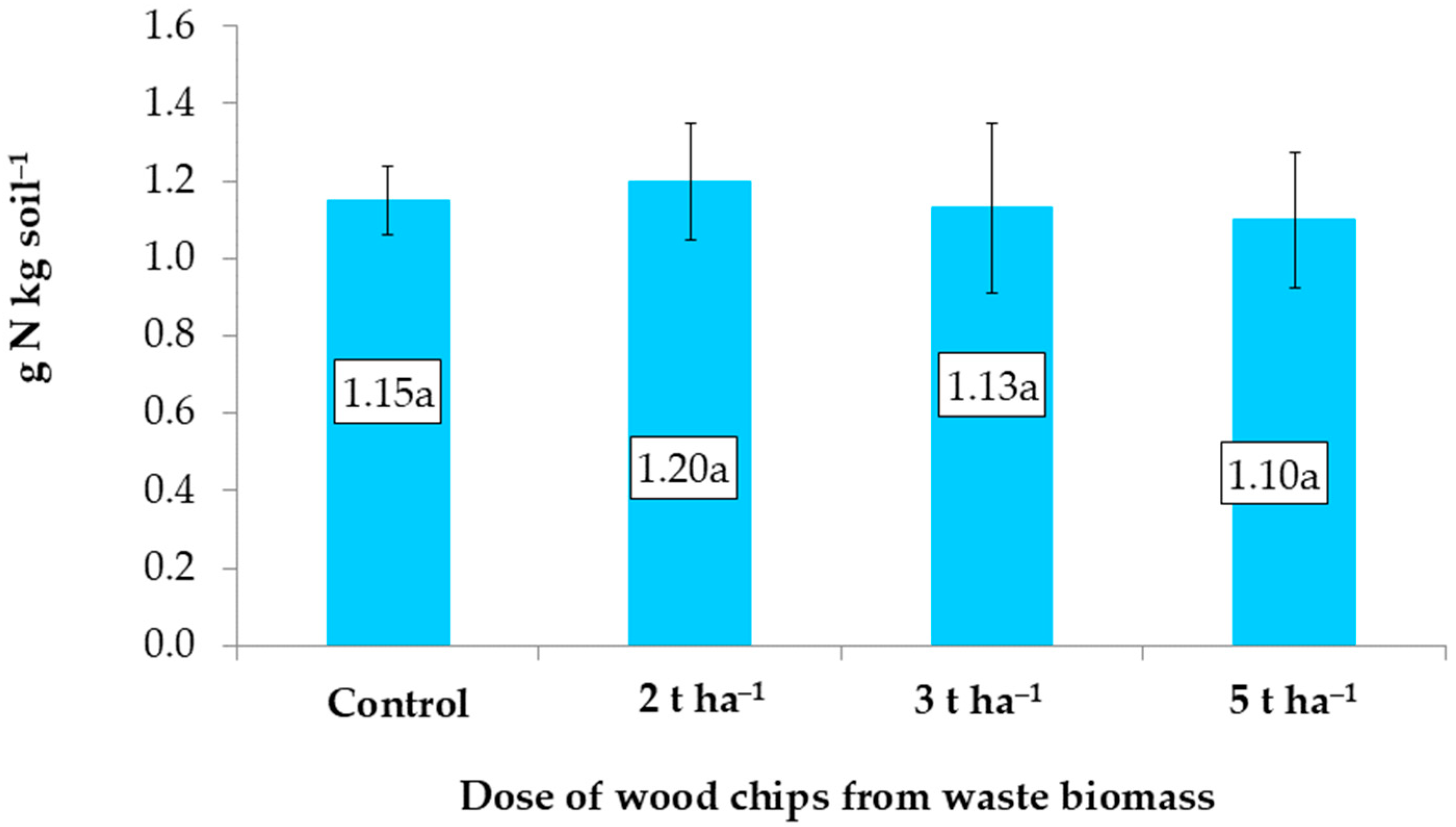
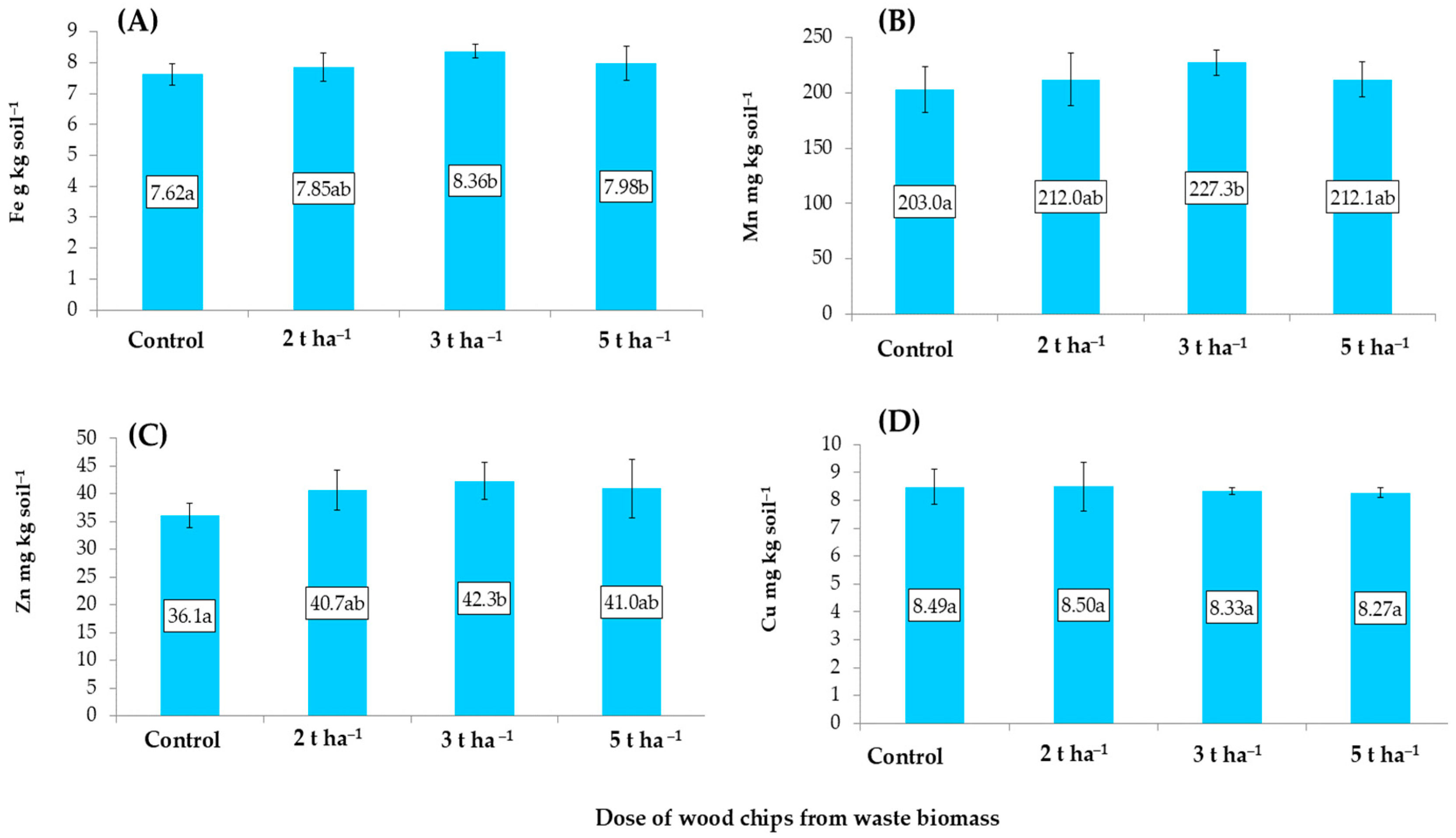
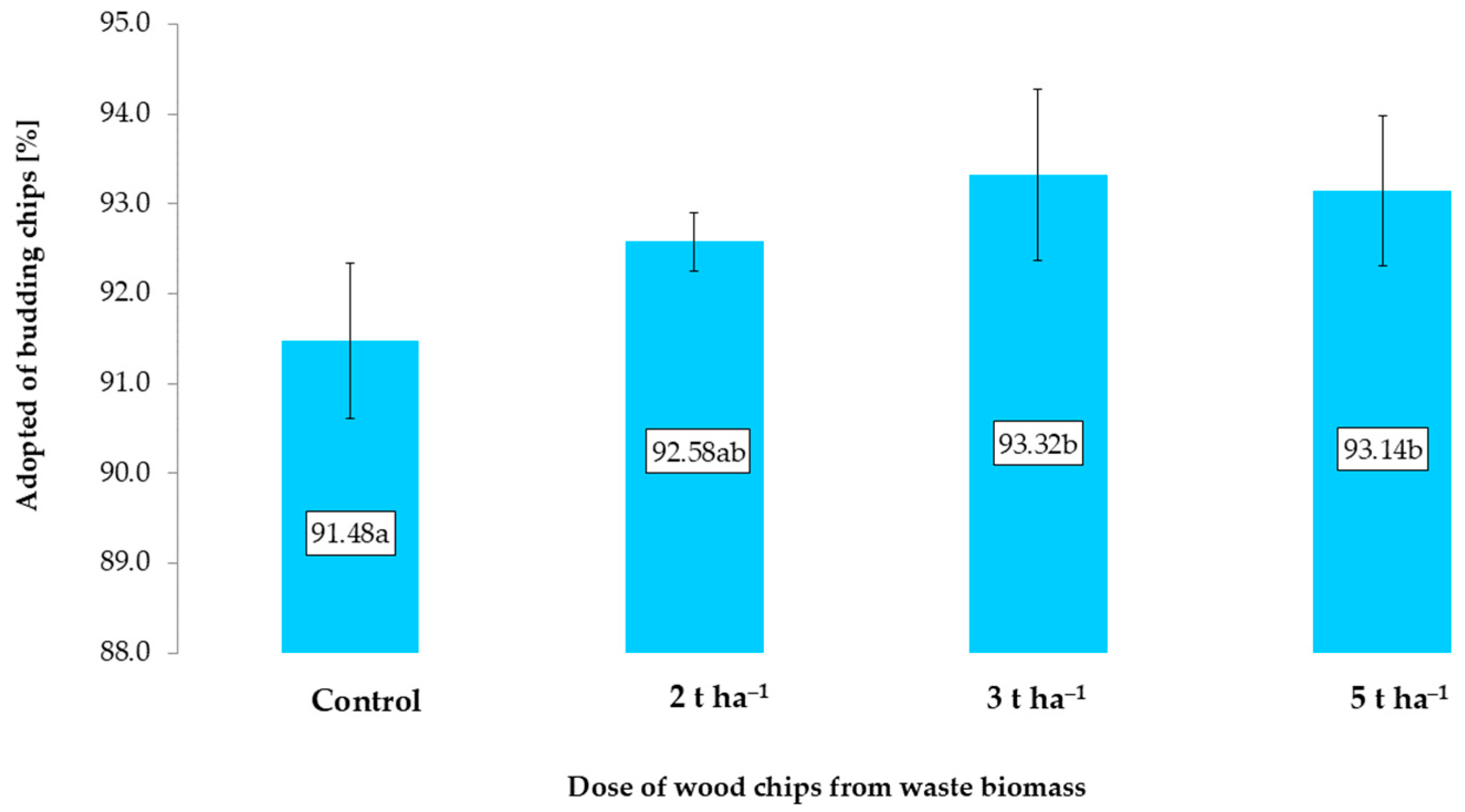
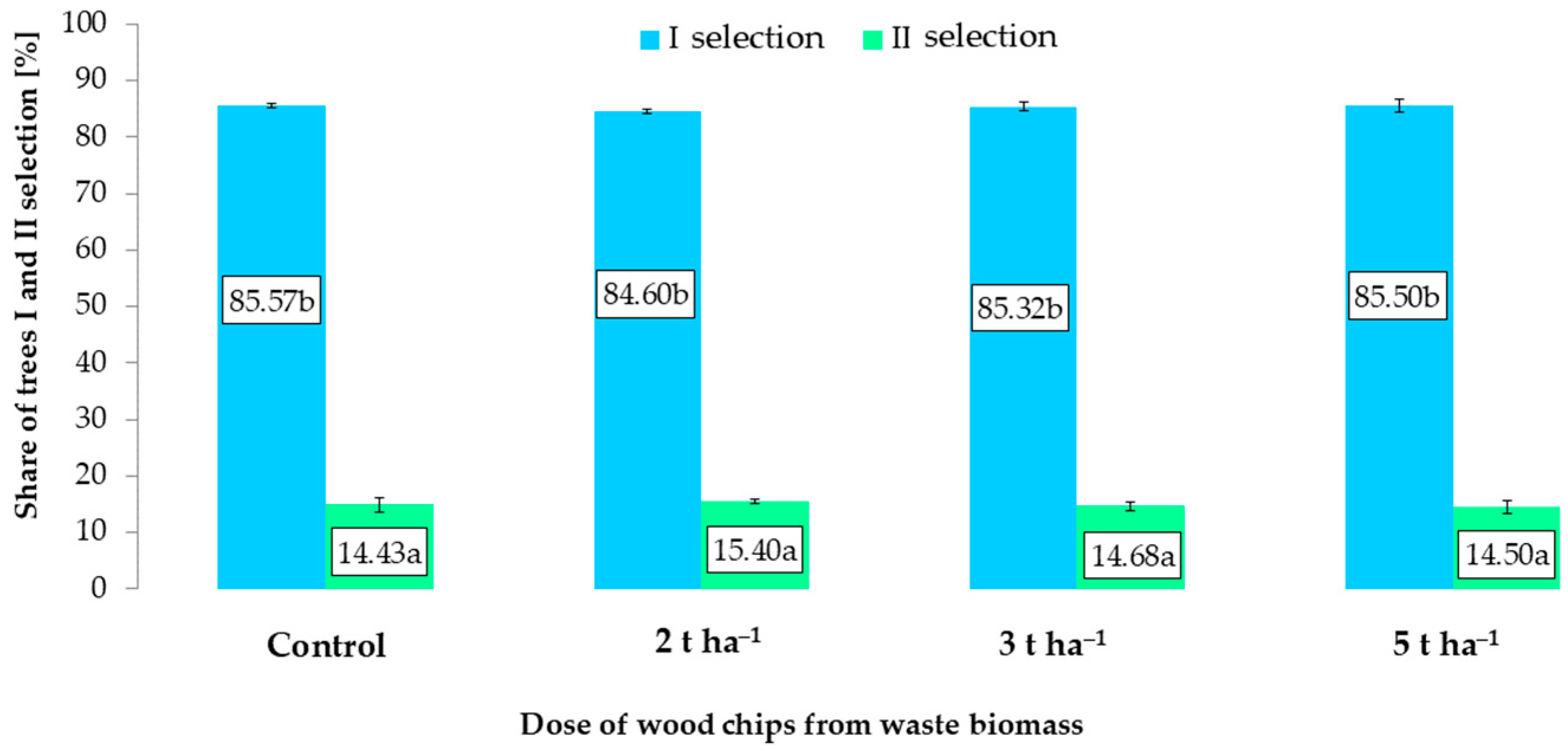
| Parameters | |||||||||||
|---|---|---|---|---|---|---|---|---|---|---|---|
| TOC | N | S | C:N | Ca | K | Mg | P | Fe | Mn | Zn | Cu |
| % | - | g kg−1 d.m. | mg kg−1 d.m. | ||||||||
| 49.8 ± 3.4 | 1.19 ± 0.4 | 0.08 ± 0.02 | 41.8 ± 8.9 | 6.59 ± 0.45 | 4.87 ± 0.34 | 1.42 ± 0.12 | 1.87 ± 0.43 | 65.4± 6.3 | 73.8 ± 6.2 | 23.1 ± 2.3 | 7.64 ± 0.36 |
| Year | Parameter | Month | |||||||
|---|---|---|---|---|---|---|---|---|---|
| IV | V | VI | VII | VIII | IX | X | Mean | ||
| I | Kvalue | 0.99 | 2.09 | 0.98 | 0.92 | 0.84 | 0.70 | 0.80 | 1.04 |
| Humidity characteristics | Dry | Humid | Dry | Dry | Dry | Dry | Dry | Quite dry | |
| II | K value | 0.99 | 2.11 | 0.16 | 0.85 | 0.09 | 1.05 | 1.58 | 0.97 |
| Humidity characteristics | Dry | Humid | Extremely dry | Dry | Extremely dry | Fairly dry | Optimum | Dry | |
| III | K value | 1.70 | 0.46 | 0.73 | 0.53 | 0.63 | 1.06 | 2.55 | 1.09 |
| Humidity characteristics | Fairly humid | Very dry | Dry | Very dry | Very dry | Fairly dry | Very humid | Fairly dry | |
| Mean I–III | K value | 1.23 | 1.55 | 0.62 | 0.77 | 0.52 | 0.94 | 1.64 | 1.03 |
| Humidity characteristics | Fairly humid | Optimum | Very dry | Dry | Very dry | dry | Fairly humid | Fairly dry | |
| Mean 1986–2002 | K value | 1.96 | 1.93 | 1.71 | 1.61 | 1.26 | 1.92 | 1.97 | 1.76 |
| Humidity characteristics | Fairly humid | Fairly humid | Fairly humid | Fairly humid | Fairly dry | Fairly humid | Fairly humid | Fairly humid | |
Disclaimer/Publisher’s Note: The statements, opinions and data contained in all publications are solely those of the individual author(s) and contributor(s) and not of MDPI and/or the editor(s). MDPI and/or the editor(s) disclaim responsibility for any injury to people or property resulting from any ideas, methods, instructions or products referred to in the content. |
© 2024 by the authors. Licensee MDPI, Basel, Switzerland. This article is an open access article distributed under the terms and conditions of the Creative Commons Attribution (CC BY) license (https://creativecommons.org/licenses/by/4.0/).
Share and Cite
Matłok, N.; Szostek, M.; Balawejder, M. Soil Recycling of Waste Biomass in the Production of Malus domestica Fruit Tree Seedlings. Agriculture 2024, 14, 1806. https://doi.org/10.3390/agriculture14101806
Matłok N, Szostek M, Balawejder M. Soil Recycling of Waste Biomass in the Production of Malus domestica Fruit Tree Seedlings. Agriculture. 2024; 14(10):1806. https://doi.org/10.3390/agriculture14101806
Chicago/Turabian StyleMatłok, Natalia, Małgorzata Szostek, and Maciej Balawejder. 2024. "Soil Recycling of Waste Biomass in the Production of Malus domestica Fruit Tree Seedlings" Agriculture 14, no. 10: 1806. https://doi.org/10.3390/agriculture14101806
APA StyleMatłok, N., Szostek, M., & Balawejder, M. (2024). Soil Recycling of Waste Biomass in the Production of Malus domestica Fruit Tree Seedlings. Agriculture, 14(10), 1806. https://doi.org/10.3390/agriculture14101806








